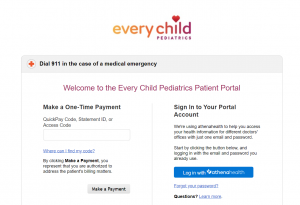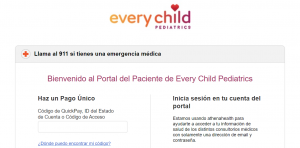Patient portals are patients’ own private gateway to their provider. They can exchange secure messages, check on appointments, and get copies of their personal health records. Providers benefit from more efficient workflows, cost savings, and improved health outcomes. But there’s a catch: They’re only beneficial if patients and providers actually use the service.
 A full 90 percent of providers offer the tool but only one third of patients access them and just 20 percent use one regularly, according to a 2017 U.S. Government Accountability Office report. Subsequent research reveals that even if patients sign up for this online access they often don’t come back, making many skeptical about introducing this digital solution. Sure, patient portals show promise, but will enough people use them to make it worthwhile?
A full 90 percent of providers offer the tool but only one third of patients access them and just 20 percent use one regularly, according to a 2017 U.S. Government Accountability Office report. Subsequent research reveals that even if patients sign up for this online access they often don’t come back, making many skeptical about introducing this digital solution. Sure, patient portals show promise, but will enough people use them to make it worthwhile?
Consider Every Child Pediatrics (ECP) in Denver, one of the largest safety net providers for low-income and disadvantaged children in Colorado. The health center serves nearly 24,000 patients – mostly Latino patients using Medicaid — at its 12 medical offices and school- based health centers. It offered an electronic health record (EHR) and patient portal — both powered by Athenahealth — but until recently the health center was barely using the portal. That’s because its functionality was so limited that patients (and their parents) and providers had no compelling reasons to sign on to it. In fact, until the middle of 2020, the patient portal languished, visited by only a few staff members and patients (those 13 and older had access) and their parents.
In the past, nearly all communication between families and providers was through phone calls. But anyone who has ever been on hold trying to reach a healthcare provider knows that phone calls can mean frustratingly long wait times. That said, communicating directly with a nurse, medical assistant, or physician can often avoid a trip to a medical clinic—especially in the pediatric population.
Meet Jovanny and Destany. Destany tell us “ Every Child Pediatrics are very good with their patients. My child is very comfortable here.” pic.twitter.com/bJtmxd9S93
— Every Child Pediatrics (@EveryChildPeds) November 12, 2020
Every Child Pediatrics wanted to pilot a project to improve the portal’s convenience, efficiency, and communications for staff, patients, and parents. ECP also hoped that digital information sharing would have an impact on improved outcomes, too. In July 2020, the health center hired an innovation project manager from within its ranks to oversee the portal expansion. The project manager’s goal: helping develop clinical workflows, training staff, and rolling out features that make accessing the patient portal a go-to for patients, parents, and staff alike.
The organization also created an innovation committee to evaluate the pilot project. The committee—which included staff members from all parts of the organization, including call center, front office, nursing, physicians, billing, and IT—gathered forms, documents, and healthcare information that would optimize patient quality of care. “”In the past, the portal had been considered a fail, so all parties were understandably hesitant about change,” says Paul Brown, Every Child Pediatrics’ innovation manager. “We’ve come a long way in a relatively short period of time.”
Connecting Families and Providers via Tech Tools
Brown knew he and his innovation pilot project team had their work cut out for them. From surveys and anecdotal feedback from employees, they knew that the portal had been unsatisfactory for both patients and staff.
The project leaders also knew they would need to provide incentives to make the switch. They began by offering patients vaccination records via the portal, as well as lab results and other useful documents that would otherwise require a clinic visit. They also made it possible for patients to ask nurses clinical questions via the portal versus the call center.
On the staff side, the project team offered education and training so staff had a better understanding of the benefits of portal communication and how to use it. “We worked to make staff—especially older staff who may be less tech savvy—to become more confident and comfortable navigating the portal through training sessions,” says Brown. “Providers who expressed a lack of time to do training were given a basic rundown of why they needed to use the portal.”
Trainings included how to view the patient portal from a patient’s perspective: how to navigate the portal, how to upload aftercare summaries, how to delete and upload information, and how to respond and create messages there.
Initially, patients could send messages to the organization directly via the patient portal. First, the team made it easy for patients to send messages via the patient portal. Over six months, new functions were introduced and tested, including self-check-in/remote check-in, clinical questions, patient feedback, and provider uploading of general health forms and lab results. Patients could now also pay outstanding balances and view recent appointment notes. In addition to improving communication, workflows and efficiency, ECP wanted to ensure that patients had access to their medical information to give patients the option of updating their social health histories.
Our employees picking up donated Thanksgiving dinners for our patients families. #HappyThanksgiving2020 🦃 pic.twitter.com/eoLWoRjHGR
— Every Child Pediatrics (@EveryChildPeds) November 25, 2020
The portal wasn’t the only technology solution to get a boost during the project. ClearTriage, an online decision support software designed to help nurses triage and answer questions from patients more quickly and accurately, was more formally integrated into ECP’s workflow. One ECP nurse was already using the tool and found it such a positive experience that other nursing staff were keen to use it too.
“Our workflow is much easier now that we have the patient portal and ClearTriage,” says RN Kim E, on staff at ECP for four years. “With the portal we can quickly and easily respond to a family’s inquiries” instead of playing phone tag. She added that nurses could now simply publish completed forms to the portal for the family to view or download instead of the multiple-step process of sending out password protected, encrypted email, or faxing/mailing. ClearTriage has been wonderful in that we are able to send parents a link to home care advice, which also saves nurses a lot of time.”
Overcoming Obstacles
Bolstering patient portal use—from around 25 percent in July 2020 to around 48.8 percent use in April 2021—has been a success for ECP. Not only are patients now able to send ECP questions regarding billing, scheduling, and clinical questions, they can also upload documents or images to their messages.
But there have been workflow and functionality hurdles to sort through along the way. For instance, the patient portal can be toggled for Spanish language speakers but initially the drop-down menu options to the patient portal home page did not translate into Spanish. That technological oversight was corrected within a couple of weeks by the electronic health record provider, says innovation manager Brown, who adds that many bugs in these online innovations are worked out in real time during these pilot testing phases.
Other hiccups were quickly addressed. Call center times ballooned to 30 minutes as call center staff walked patients through how to navigate the portal, which was new to most of them, staff included. That was rectified by the addition of a portal use training video, a link to which was texted to patients. Early on, there were instances of patient messages going to the wrong “buckets” (call center versus RN), which delayed response times due to the need for re-routing. And some parents with more than one child mistakenly sent the wrong patient information to the wrong account. “There needed to be a lot of patient education as this was also new for our patient population,” notes Brown. “It was a learning curve for all involved.”
Have questions about the new Public Charge Rule? With this new policy in effect, we are here to help and offer support for immigrant families: https://t.co/AUW1ydKbO8 pic.twitter.com/ya77uQMFpH
— Every Child Pediatrics (@EveryChildPeds) March 4, 2020
During the six-month pilot, Every Child Pediatrics’ phone service provider, 8×8, tracked call wait times, call length times, and the number of calls coming into the call center. 8×8 also updated the organization’s hold message to inform patients of the benefits of the patient portal, which resulted in more sign ups, notes Brown.
ECP expected to see a reduction in call volume and call wait times with the beefing up of the patient portal system. Similarly, the organization expected to see a decrease in nurse call volume with the widespread introduction of ClearTriage’s clinical questions’ function. But there was a catastrophe no one could have anticipated that upended those assumptions: COVID-19.
Unsurprisingly, after the coronavirus pandemic hit, phone calls and phone call wait times actually increased. ECP was able to adapt relatively quickly via its EHR to offer remote check-in – and at the same time offer patients (and their parents) the option of signing up for the patient portal.
Patients were excited by the possibility of the portal, but staff had a more tempered reaction. “It was hard to receive buy-in from some staff,” says Brown, who fielded comments such as: ‘We’ve tried this before; it didn’t work.’ ‘How is this going to impact my job?’ ‘Is this going to create more work for me?’ ‘How is this going to make things more efficient?’
The innovation manager worked one-on-one with skeptics to bring them on board. Knowing there was support for change—and a point person to answer questions and address challenges—appeared to help win reluctant staffers over.

Bottom line: The portal offers benefits to providers and patients
Patients and providers are now invested in the portal’s success, says Brown. Both parties are very vocal about what works and what doesn’t, he says, which is helpful for triaging how to improve the service.
The pilot’s success led to the portal’s full integration into ECP’s workflow. Says one patient of five years about the improvement: “[In the past] it was difficult to talk to anyone at the office. I would be on hold for a long time and still have to leave a message for a call back. I enjoy being able to send a message directly to my provider. The response time seems faster and is more convenient for me.”
Centralized schedule representative Brisa Solis agrees. “Families are able to request appointments via the portal and can upload pictures and documents,” she says. “It seems easier for the patient.”
Other frontline staffers echo these comments. “Prior to the patient portal, our families needed to come to the office in order to receive any documents requested,” says Rosa Ballesteros, centralized scheduling manager, who has worked for ECP for four years. “Our call volume was also higher since our families had to wait in queue in order to request a call back from a nurse.” The improved portal functionality has changed that. “The patient portal has made it easier for our families to communicate with us. It has also made the call center job more organized. The messaging functionality has worked great,” she adds, noting that the scheduling option was “a bit tricky and non-user friendly” initially. And, in hindsight, says Ballesteros, it would have been helpful to have had a video guide for families that staff could have directed patients and parents to from the get-go.
The upgraded patient portal experience continues to evolve at ECP. The patient portal “allows us to provide options for our patients around communication, which increases overall patient satisfaction. It also allows us to provide better service to our patients by providing a secure way to send photos, forms, and medical records,” says Andee Barocas Lockhart, a clinical nurse manager who has worked at ECP for six years. “ClearTriage has allowed the RNs the ability to send handouts securely and easily to the patients providing written instructions rather than just verbal information that can feel overwhelming, especially when [parents] have a sick child at home.”

“There was a lot of trial and error that needed to happen with the portal messages and we were able to solve those issues as best we could,” adds Barocas Lockhart. “The Athenahealth portal is not the most user-friendly—from our perspective and that of the patients.. We are doing the best we can with what we have to work with.”
While the goal is to have 100 percent of patients actively using the portal, Brown knows that some patients don’t have access to computers or smart phones to make that a reality. In addition, some undocumented families resist being online, despite assurances the information is private and protected. That said, each month, more of the organization’s patients sign up for the service. And of those that do, surveys show that the vast majority have a good experience. After a marked increase during the pilot, “we’ve plateaued on sign-ups,” says Brown. “But we’re still trending in the right direction and we still have this top of mind with staff. The patient portal is here to stay. We continue to look for ways to make it even more efficient, helpful, and user-friendly.”
Lessons Learned

Downtown Denver sculpture
Provide patient education. For instance, offer information on how to use portal messaging correctly to ensure there aren’t delays in response times around clinical questions. This is especially important if there are multiple patient accounts associated with one email address.
Find a workflow solution that allows for electronic document filing. This solution could be with either an existing EHR vendor or another service that allows patient registration forms and questionnaires to be electronically uploaded. Currently Every Child Pediatrics’ forms cannot be electronically filled out and submitted. Patients still need to fill out paperwork in the office.
Implementing innovation takes time. That’s true for patients, parents, staff, and providers. Staff education needs to include individualized support for each department, including call center employees, front desk staff, nurses, medical assistants, and pediatricians.
Expect slow but steady change and plan for ongoing training, education, and support. This should include not only patients and their parents, but the entire health center team.
Next Steps
- Keep monitoring, collecting, and sharing data regarding use of the patient portal.
- Continue to use ClearTriage and measure the impact on call center and nursing team call metrics.
- Solicit feedback from patients and staff regarding the patient portal and make changes as necessary.
- Implement a new initiative to focus on two critical portal functions: (1) Collecting demographic and screening documents and data via the portal, and (2) offering patients and their parents online scheduling.
- Review Every Child Pediatrics’ mission statement and strategic goals for 2021 to see how these next steps align with overall organizational goals.
- Analyze metrics and data on portal adoption rates to help make business decisions for the health center.
______________________________________________________________________________________
Every Child Pediatrics is part of a CCI collaborative designed to support innovation to better address the health of historically underserved Coloradan communities. The Colorado Health Innovation Community (CHIC) helps health care safety net organizations identify, test, and evaluate new approaches with the potential to improve care experiences for low-income Coloradans. The program draws on human-centered design and sustainable solutions for patients and staff alike, with an emphasis on technological innovation that can help strengthen health and health care. ECP is one of seven clinics in the cohort, including Clinica Family Health, Jefferson Center for Mental Health, Melissa Memorial Hospital, Mental Health Center of Denver, Solvista Health, and STRIDE Community Health Center. Partners on the project include Colorado Health Foundation, The Colorado Health Access Fund of the Denver Foundation, Rose Community Foundation, Community First Foundation, and Colorado Access.
Find this useful or interesting? We’re constantly sharing stuff like this. Sign up to receive our newsletter to stay in the loop.

